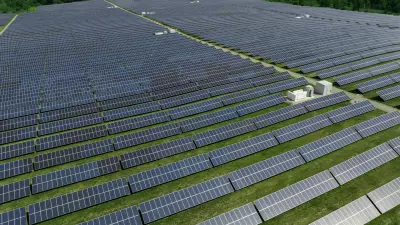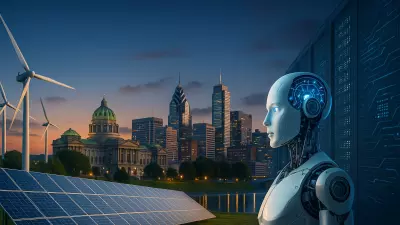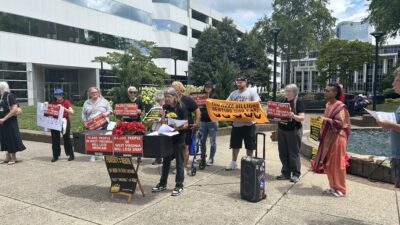In Athens, Ohio — the city and the county — they’ve built a solar-powered water treatment plant and an emergency medical services station, and installed electric vehicle charging stations at the community library and elsewhere.

Cincinnati has an Electric Vehicle First policy when it comes to replacing its fleet of vehicles.
Pittsburgh, too, has bought electric vehicles for many of its inspectors.
This trend will likely continue over the next decade, spurred on by billions of dollars in federal funding that will flow to communities in a bid to move away from fossil fuels and to decarbonize.
Many cities, including Pittsburgh, Cincinnati and Athens, have set time frames by which they want to drastically reduce their carbon footprint.
In Postindustrial regions where identity is still sentimentally — and sometimes, defensively — tied to steel, coal, and traditional agricultural methods, there’s a particular emphasis baked into the Inflation Reduction Act on how to push these regions to use renewable energy sources.
“There’s some really good leading indicators,” said Grant Ervin, director of environmental social governance for S&B USA Construction. “If you look at places like Pittsburgh, Cincinnati or Columbus, all have been at the forefront at developing and advancing EV technology or purchasing renewable energy.”
For example, in Cincinnati, leaders adopted an EV First policy for city-owned vehicles — if an electric vehicle option is available, it should be the first choice unless deemed otherwise, said Oliver Kroner, interim director of the Office of Environmental Sustainability for the City of Cincinnati.
The city has purchased electric vehicles for building inspectors and parking enforcement officers, and bought hybrid vehicles for its police department.
It’s “waiting and watching the technology on the larger vehicles,” such as sanitation trucks, he said.
The city for years has been retrofitting its buildings to make them more energy efficient, Kroner said.
“To redo an economy, you have to have access to decent roads and bridges, you have to have broadband, you have to have an energy grid to develop.” — Kate Gordon, senior advisor to the secretary of energy
“We have solar on 28 facilities, and we have a solar farm that is providing 35 megawatts of electricity to city facilities,” Kroner said.
Cincinnati leaders hope to be using 100 percent renewable energy by 2035 and be carbon-neutral by 2050.
Incentives notwithstanding, it isn’t that easy: Decades-old infrastructure doesn’t support a quick transition to renewable energy. For example, much of the equipment on the electric grid needs to be upgraded.
The infrastructure was built for communities in which electricity flows one way — from the grid to people.
The City of Pittsburgh wants to reduce carbon emissions by 50 percent by 2030, and Pittsburgh Regional Transit (formerly the Port Authority of Allegheny County) has set a target of having a zero-emissions fleet by 2045, said Ervin, who was the city’s resilience officer until February.
While Pittsburgh did not, at the time, consider replacing its sanitation vehicles and police cruisers, other cities have.
“The market is starting to move rapidly for heavier duty equipment, so you now have garbage trucks that can be electrified and you are seeing police cruisers that are being electrified,” Ervin said.
Boise, Idaho, unveiled its first electric recycling truck last year, and the City of Los Angeles has committed to having a 100 percent electric sanitation fleet by 2035. The police department in Logan, Ohio, about 50 miles southeast of Columbus, received its first Tesla Model Y electric cruiser in December.
The public transit system in Athens, about 25 miles southeast of Logan, runs 14 smaller shuttle-type buses, and recently unveiled its first electric bus. “If it goes well, then, absolutely, they want to transition all their fleet,” said Sarah Conley-Ballew, program director of sustainable energy solutions at Rural Action, a nonprofit that serves the Appalachian Ohio region.
Rural Action helped the city install DC fast-charging stations, which can fully charge a car in about 30 minutes, and Level 2 stations, which take four to six hours to fully charge a car. According to Plug Share, there are 31 public charging stations in the Athens area, three of which are free.
The charging station at the local library was installed in 2019 and has shown an increase in usage during the day and overnight, said Conley-Ballew.
But “we are really trying to think bigger than just Athens, and we could use more in Athens County and throughout southeast Ohio, in smaller towns and along southern routes where there is a charging desert,” she said.
“That’s the hope and that’s really the need, and federal funding is obviously going to be really important,” Conley-Ballew said.
“The Inflation Reduction Act will give a burst of momentum as a lot of tax credits apply to city governments,” said Cincinnati’s Kroner.
The federal government’s goal is to ensure “no communities are left behind” as this transition to renewable energy takes place, said Brian Anderson, executive director of the interagency working group on coal and power plant communities for the U.S. Department of Energy.
The department has identified 12 Priority Energy Communities, which areas in western Pennsylvania, West Virginia, Ohio, Kentucky, Illinois, North Dakota, and New Mexico — areas that have the largest dependence on a sole source of income or don’t have as diverse an economy.
The DOE’s interagency working group’s work also “includes the broader questions about transition, to allow all these regions to be part of this new economy,” said Kate Gordon, senior advisor to the secretary of energy, likening the transition to the move away from the steel industry.
Federal funding would include investments in broadband — “a huge tool in providing jobs for displaced workers,” she said — roads and bridges, incentivizing investments in energy communities, hydrogen hubs, reclaiming abandoned mine lands, and brownfield redevelopment.
“To redo an economy, you have to have access to decent roads and bridges, you have to have broadband, you have to have an energy grid to develop,” she said.
The work also includes making existing buildings in Postindustrial cities that have scores of older structures more energy efficient.
“Everybody wants to talk about this stuff in nuances, but we just dealt with a Category 4 hurricane that just eviscerated a major swath of the United States. IF we do make these corrections, there are positive attributes that can occur — cleaner buildings, healthier communities, better air quality. We all stand to benefit. So, why wouldn’t we do it?” — Grant Ervin, director of environmental social governance for S&B USA Construction
“A lot of this building stock will be around for the next 50 years,” Gordon said. “We are really interested in existing infrastructure. We are not building new cities.”
The Fixing America’s Surface Transportation Act called for the designation of interstate corridors to become either natural gas, gaseous and electrification ready, said Marcy Rood, technology integration manager at Argonne National Labs.
Part of that includes setting up EV charging stations along the Interstate 80 corridor from New Jersey to Iowa, she said.
“Every state is developing their NEVI (National Electric Vehicle Initiative) funding,” Ervin said
About $170 million has been allocated to Pennsylvania, and $160 million to Ohio. “It’s going to be invested in these corridor (of) infrastructure,” he said.
Part of Rood’s work includes working with landowners and municipalities along the routes to look at the ideal locations for charging stations.
Pennsylvania’s NEVI plan calls for having DC fast-charging stations at least every 50 miles and within one mile of an interstate exit or highway intersection along designated Alternative Fuels Corridors.
It also supports PennDOT’s overall electrification goal for 95% of Pennsylvanians to live within 15 miles of a public EV charging station and 50 percent of municipalities to have at least two Level 2 plugs open to the public around the clock by 2027.
“We certainly want to make it as convenient as possible for consumers,” Rood said.
The transition to renewable energy, however, is not entirely based on federal help. “There’s a real focus on incentivizing and providing for the private sector. None of what we are talking about is without significant private sector investment,” DOE’s Gordon said. “We are providing the classic government support in the early stage. Ultimately, this is going to have to be a whole economy project with a lot of private funding.”
Ervin sees transitioning to renewable energy sources as vital.
“Everybody wants to talk about this stuff in nuances, but we just dealt with a Category 4 hurricane that just eviscerated a major swath of the United States,” he said. “If we do make these corrections, there are positive attributes that can occur — cleaner buildings, healthier communities, better air quality. We all stand to benefit. So, why wouldn’t we do it?”







